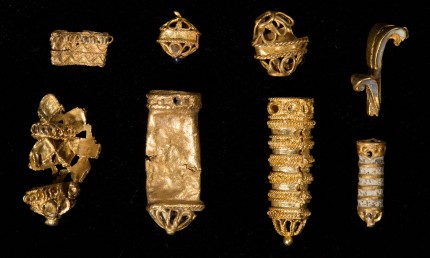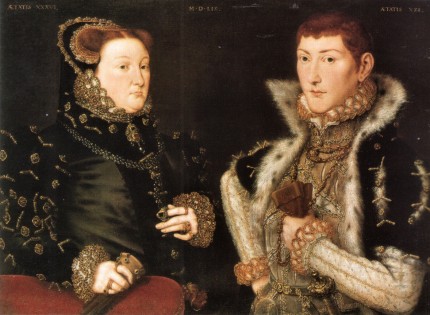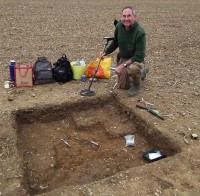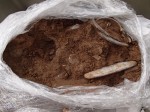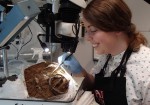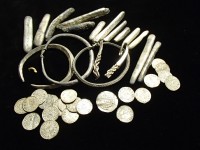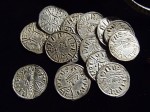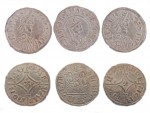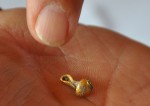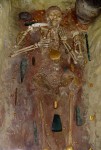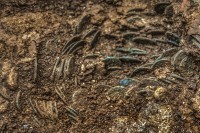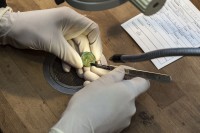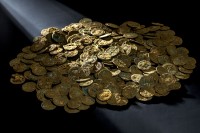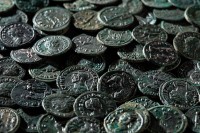 Chinese archaeologists have unearthed the largest, most complete and best preserved Western Han Dynasty (206 B.C.-25 A.D.) cemetery near Nanchang, the capital of eastern China’s Jiangxi Province. The cemetery has only eight tombs, but they’re huge, covering 40,000 square meters (430,556 square feet or about 10 acres). The largest tomb has a chariot burial with walls almost 900 meters (2,953 feet) long. Excavations of the site began five years ago but the discoveries were only announced earlier this month, with new finds still coming in.
Chinese archaeologists have unearthed the largest, most complete and best preserved Western Han Dynasty (206 B.C.-25 A.D.) cemetery near Nanchang, the capital of eastern China’s Jiangxi Province. The cemetery has only eight tombs, but they’re huge, covering 40,000 square meters (430,556 square feet or about 10 acres). The largest tomb has a chariot burial with walls almost 900 meters (2,953 feet) long. Excavations of the site began five years ago but the discoveries were only announced earlier this month, with new finds still coming in.
The site is a city of the dead, with memorial temples, roads and drainage systems structured around the tombs. The tombs are the most intact Western Han yet found, their layout exceptionally clear. The chariot burial is exceptional. There are five chariots, each with four horses sacrificed in a funerary ritual, and more than 3,000 artifacts and fittings decorated with gold and silver. It is the only tomb found south of Yangtze River to have real chariots, or real vehicles of any kind, for that matter.
 And that’s just the beginning of the wealth discovered in these tombs. The main tomb was found to hold more than 10 tons of Wuzhu bronze coins, more than two million individual pieces. The coins date to the reigns of three Western Han emperors: Emperor Wu (141-87 B.C.), Emperor Zhao (87-74 B.C.) and Emperor Xuan (74-49 B.C.). Most of the coins were in a pile, but archaeologists found six strands of 1,000 coins each. Ancient sources reference 1,000 low-value Wuzhu coins being strung together via the square hole in the center to create a larger denomination. Based on the documentary evidence, this monetary adaptation was thought to have started in the Tang Dynasty (618-907 A.D.), but no archaeological evidence of it has been found before. The discovery of six intact groups of 1,000 coins strung together on hemp ropes confirms the historical sources and pushes back the date of the practice at least 600 years. To give an idea of the value, the ancient documents say that ten of the strings could be exchanged for one Jin (250 grams) of gold. Ten Jin was the total net worth of a middle-class family in the Western Han Dynasty.
And that’s just the beginning of the wealth discovered in these tombs. The main tomb was found to hold more than 10 tons of Wuzhu bronze coins, more than two million individual pieces. The coins date to the reigns of three Western Han emperors: Emperor Wu (141-87 B.C.), Emperor Zhao (87-74 B.C.) and Emperor Xuan (74-49 B.C.). Most of the coins were in a pile, but archaeologists found six strands of 1,000 coins each. Ancient sources reference 1,000 low-value Wuzhu coins being strung together via the square hole in the center to create a larger denomination. Based on the documentary evidence, this monetary adaptation was thought to have started in the Tang Dynasty (618-907 A.D.), but no archaeological evidence of it has been found before. The discovery of six intact groups of 1,000 coins strung together on hemp ropes confirms the historical sources and pushes back the date of the practice at least 600 years. To give an idea of the value, the ancient documents say that ten of the strings could be exchanged for one Jin (250 grams) of gold. Ten Jin was the total net worth of a middle-class family in the Western Han Dynasty.
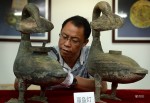 So far, the excavation of the cemetery has unearthed more than 10,000 artifacts, including bronze mirrors, bells, cooking pots, wine vessels and two exceptional lamps shaped like geese with fish in their beaks which in addition to being beautiful are also practical. The candle was held in the mouth of the goose so that smoke would enter the goose’s body through the fish. The goose lamp’s belly would be filled with water and the trapped smoke would dissolve into it like a one-way bong. (The geese don’t exhale.) They’ve also found jade objects, wood tablets, bamboo slips and musical instruments, among them a se (a plucked zither with 25 strings), pan flutes and sheng (a mouth-blown reed pipe instrument). There are also terracotta figurines known as Kuregaku figurines depicting how the instruments were played.
So far, the excavation of the cemetery has unearthed more than 10,000 artifacts, including bronze mirrors, bells, cooking pots, wine vessels and two exceptional lamps shaped like geese with fish in their beaks which in addition to being beautiful are also practical. The candle was held in the mouth of the goose so that smoke would enter the goose’s body through the fish. The goose lamp’s belly would be filled with water and the trapped smoke would dissolve into it like a one-way bong. (The geese don’t exhale.) They’ve also found jade objects, wood tablets, bamboo slips and musical instruments, among them a se (a plucked zither with 25 strings), pan flutes and sheng (a mouth-blown reed pipe instrument). There are also terracotta figurines known as Kuregaku figurines depicting how the instruments were played.
Then there’s the lacquer screen. It was broken into vertical painted panels. One of the panels has a portrait of a man who archaeologists believe may be Confucius. If they’re right, it will be the earliest known portrait of Confucius found in China. There are pictures of the screen in situ here and video of it here. Fair warning: you can’t see the portrait at all. You can’t even tell it’s a screen, frankly.
 But wait! There’s more! On Tuesday archaeologists struck gold, specifically, 25 gold ingots shaped like hooves and 50 large and heavy gold coins. This is the greatest amount of gold ever discovered in a Han Dynasty tomb.
But wait! There’s more! On Tuesday archaeologists struck gold, specifically, 25 gold ingots shaped like hooves and 50 large and heavy gold coins. This is the greatest amount of gold ever discovered in a Han Dynasty tomb.
While the identity of the dignitary buried in the largest tomb has yet to be conclusively established, archaeologists believe it was Liu He, the grandson Emperor Wu, the Han dynasty greatest’s emperor who reigned for 54 years (141-87 B.C.). Liu He did not take after his venerable and supremely competent grandfather. He reigned for a mere 27 days, from July 18th to August 14th 74 B.C., before being deposed by the Dowager Empress Shangguan and court officials on 1127 charges of misconduct, most of them revolving around his sexing, feasting, hunting and all-around partying when he was supposed to be in mourning for his uncle, the deceased emperor. He was replaced by Emperor Xuan, the great-grandson of Emperor Wu, who had been raised a commoner after his father and grandfather died when the latter was falsely accused of practicing witchcraft against Emperor Wu.
 Liu He was stripped of his titles after he was impeached, but in 63 B.C. Emperor Xuan was persuaded to make him the Marquis of Haihun which had the added advantage of shipping a potential rival away from the capital of his former principality (modern-day Jining) 900 miles south to the modern-day Jiangxi province. He died four years later in 59 B.C. The Haihunhou cemetery is named after the title, which in turn was a feudal descendant of a small kingdom that had once ruled the north of Jiangxi.
Liu He was stripped of his titles after he was impeached, but in 63 B.C. Emperor Xuan was persuaded to make him the Marquis of Haihun which had the added advantage of shipping a potential rival away from the capital of his former principality (modern-day Jining) 900 miles south to the modern-day Jiangxi province. He died four years later in 59 B.C. The Haihunhou cemetery is named after the title, which in turn was a feudal descendant of a small kingdom that had once ruled the north of Jiangxi.
Lead archaeologist Li Xiaobin of the China National Museum, who has studied an impressive 4,000 Han Dynasty tombs, hopes the question of who the main tomb was built for will be answered when the sealed coffin in the central mausoleum is opened. If there’s a royal seal or jade accoutrements, that would identify the occupant as an emperor and may even identify him by name. If it is Liu He, it’s probable his wife occupies one of the other tombs and other family members or high-ranking nobles the remaining six.
The regional culture ministry has set up a number of laboratories so that researchers can examine the enormous quantity of artifacts recovered according to their relevant fields — archaeobotany, zooarchaeology, metallurgy, textile studies. Vice Minister of Culture Li Xiaojie wants the site to be excavated with an eye to a future application for the cemetery to be added to the UNESCO World Heritage List.
[youtube=https://youtu.be/Q5hy3D2rK3I&w=430]
